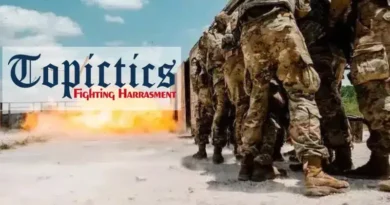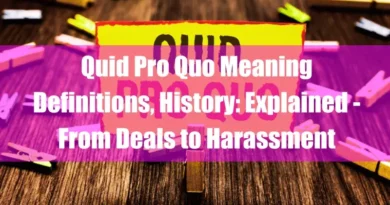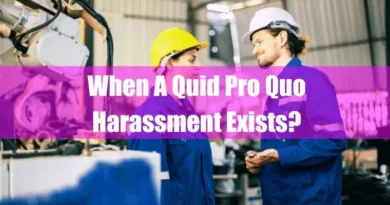I. Introduction
Quid pro quo harassment – that insidious exchange of favors for advancement, silence for security – casts a long shadow beyond the immediate power struggle. Its consequences seep into the lives of survivors, often etching invisible scars that morph into the debilitating symptoms of post-traumatic stress disorder (PTSD). This article delves into this chilling connection between quid pro quo harassment and PTSD, illuminating how the quid pro quo’s toxic cocktail of power dynamics, coercion, and betrayal fuels the fire of PTSD.
II. PTSD and Quid Pro Quo
Post-traumatic stress disorder (PTSD) is a debilitating echo of trauma characterized by flashbacks, anxiety, and hypervigilance. Quid pro quo harassment, a toxic exchange of favors for advancement or silence for security, fuels this fire. The power imbalance, coercion, and betrayal inherent in quid pro quo leave survivors feeling helpless and violated, creating the perfect breeding ground for PTSD’s intrusive symptoms and emotional scars. It’s not just a workplace grievance; it’s a trauma that lingers, haunting survivors long after the harassment ends, demanding a holistic approach to healing and a collective commitment to dismantling the power dynamics that perpetuate this cycle of suffering.
III. The Traumatic Landscape of Quid Pro Quo
Quid pro quo’s toxic cocktail of power dynamics, coercion, and betrayal creates a potent brew of trauma. Here’s how:
A. Power Dynamics
Imagine a young, ambitious employee facing an ultimatum: a promotion in exchange for “favors” from their senior colleague. The power imbalance is stark, leaving them feeling trapped and vulnerable. Their career aspirations hang in the balance, creating immense pressure and internal conflict.
B. Coercion
This isn’t just a polite request; it’s a veiled threat, a subtle manipulation. The harasser might imply negative consequences for refusing (e.g., missed opportunities, performance reviews). This constant pressure erodes autonomy and creates a feeling of helplessness.
C. Betrayal
Often, the perpetrator is someone the victim trusted, a mentor, or a colleague. This violation of trust shatters the sense of security and belonging, leaving the victim questioning their judgment and perceptions.
D. Example
A promising architect facing unwanted advances from her boss. The subtle touches, the inappropriate jokes, the late-night texts – all veiled threats to her career progression. This constant barrage of intimidation leaves her feeling unsafe, violated, and deeply betrayed.
E. Distinguishing from Hostile Work Environment
While both involve unwelcome behavior, quid pro quo is transactional. It’s a specific exchange – compliance for advancement, silence for security. Hostile environments are more pervasive, characterized by repeated offensive conduct that creates an intimidating atmosphere for everyone.
Quid Pro Quo and Hostile Work Environment
IV. PTSD: Unseen Scars of Quid Pro Quo
PTSD is not just a diagnosis; it’s a chronic stress response to trauma. Its core symptoms include:
- Intrusive thoughts and flashbacks: Vivid reliving of the harassment – the boss’s voice, the uncomfortable touch, the helpless feeling. These can occur spontaneously or be triggered by cues like the office building, a specific smell, or even a news story.
- Hypervigilance: A constant state of alertness, scanning for potential threats. The elevator feels suffocating; crowds trigger anxiety, and every interaction becomes a potential source of danger.
- Emotional numbing: An attempt to shield themselves from the pain, survivors may experience a disconnect from their emotions, feeling numb, apathetic, or emotionally distant.
- Avoidance: Anything that reminds them of the trauma – the office, work colleagues, even social situations – is avoided, shrinking their world and isolating them.
Linking Symptoms to the Experience: Violating trust and power in quid pro quo fuels these symptoms. The constant pressure to comply, the fear of retaliation, the betrayal – all feed into the hypervigilance and flashbacks. The feeling of being objectified and exploited contributes to the emotional numbing and avoidance.
Delayed Onset: Sometimes, the symptoms don’t emerge immediately. Survivors might cope initially, pushing the trauma down. But months, even years later, the stress can resurface, triggered by a seemingly unrelated event, leading to a delayed PTSD diagnosis.
These unseen scars are the lingering echoes of quid pro quo trauma, impacting the survivor’s present and future. The path to healing, however, exists, offering hope in the face of this harrowing experience.
V. The Cycle of Suffering

Quid pro quo trauma isn’t a single event; it’s a vicious cycle that perpetuates suffering. Here’s how:
A. Power Dynamics and Loss of Control
The very essence of quid pro quo is manipulating power. The survivor feels forced to relinquish control over their professional advancement, sense of agency, and personal safety. This constant power imbalance fuels feelings of helplessness and vulnerability; escaping seems impossible.
B. Erosion of Trust and Safety
The workplace, once a space of collaboration and purpose, becomes tainted. Trust in colleagues, superiors, and even the institution itself evaporates. The survivor feels constantly on guard, unable to relax or feel safe, leaving them with a lingering sense of anxiety and hypervigilance.
C. Shame, Guilt, and Self-Blame
The internal narrative often becomes self-punishing. “I should have spoken up,” “I must have done something wrong,” “I’m weak for letting this happen.” These self-criticisms deepen the emotional wounds, making seeking help or accepting that they were wronged harder.
D. Personal and Professional Impact
The survivor’s life shrinks. They may avoid social situations, withdraw from loved ones, and struggle to focus at work. The constant mental and physical stress impacts their productivity, relationships, and overall well-being.
VI. Beyond the Individual
The ripples of this trauma reach far beyond the survivor.
A. Families and Relationships
The trauma of quid pro quo harassment can strain family relationships. The survivor’s emotional withdrawal, hypervigilance, and unpredictable behavior can be confusing and frustrating for loved ones. They may not understand the underlying trauma and how it’s affecting their partner, parent, or child. This lack of understanding can lead to arguments and a sense of helplessness for those trying to support the survivor.
B. Secondary Trauma
Those who support survivors of trauma can experience secondary trauma themselves. This is characterized by emotional and psychological distress caused by prolonged exposure to another person’s suffering. Compassion fatigue, a specific aspect of secondary trauma, is a feeling of exhaustion and emotional depletion that can arise from constantly caring for someone in pain. Supporters need to prioritize their own well-being to avoid burnout and continue offering effective support.
C. Societal Cost
Unchecked PTSD is a societal burden. Lost productivity, increased healthcare utilization, untapped potential – these are the hidden costs of silence. Survivors become disengaged, their talents underutilized, their contributions silenced. The fabric of the community weakens as individuals withdraw and families suffer.
VII. Breaking the Chains: Healing is Possible
Despite the darkness, hope persists. Recovery is a marathon, not a sprint, but a journey worth taking.
A. Emphasis on Resilience
The human spirit is remarkably resilient. Survivors can and do heal from PTSD. They can reclaim their lives and rediscover their strength with support, therapy, and time.
B. Types of Therapy
Different approaches cater to individual needs. Trauma-informed therapy provides a safe space for processing the experience, while cognitive-behavioral therapy (CBT) helps manage intrusive thoughts and anxiety. Eye Movement Desensitization and Reprocessing (EMDR) can be particularly effective in addressing flashbacks and emotional dysregulation.
C. Validation and Empowerment
Healing starts with acknowledging the survivor’s experience, believing their story, and validating their pain. This empowers them to take control of their narrative and build healthy coping mechanisms like mindfulness, exercise, and creative expression.
The road to recovery is long and arduous, but survivors rewrite their stories with each step. They reclaim their power, rebuild trust, and re-emerge with a newfound strength and resilience. Their journey becomes a testament to the enduring human spirit, a beacon of hope for others facing similar battles.
VIII. A Collective Call to Action
Silence is not an option. To dismantle the insidious legacy of quid pro quo PTSD, we must act collectively:
A. Stronger Policies and Reporting
Clear, accessible reporting systems are essential. Survivors need avenues to voice their concerns without fear of retaliation. Organizations must implement mandatory training on power dynamics, harassment prevention, and trauma-informed responses.
B. Education and Awareness
Ignorance breeds tolerance. We need comprehensive education programs for employees, supervisors, and even bystanders, equipping them to recognize the signs of quid pro quo and its long-term consequences. Open conversations, public campaigns, and amplified survivor voices can break the stigma and empower others to speak up.
C. Supporting Survivors
Survivors need a lifeline, not a burden. Accessible mental health resources, tailored support groups, and compassionate leadership are crucial. We must believe their stories, validate their pain, and offer practical assistance. This isn’t just about filing complaints; it’s about fostering healing, resilience, and a renewed sense of agency.
D. Important Considerations on Quid Pro Quo Harassment and PTSD
1. Institutional Accountability:
Forget policies; empower truly independent investigations that shine a light on internal practices. Publicly report not just complaints but findings and actions taken. Shift the burden of proof from survivors to organizations, making them demonstrate a safe environment. Hit them in the wallet with graduated fines based on offense severity and history. Hold leaders personally liable for fostering or ignoring quid pro quo, sending a powerful message down the chain.
2. Intersectionality of Trauma:
It’s not just individuals; it’s layers. Gender, race, and socio-economic status amplify the trauma. Tailor support systems to address unique challenges. Culturally competent therapy? Yes. Community-based resources? Absolutely. Survivors deserve nuanced support, not a one-size-fits-all approach.
3. Legal Implications:
The law needs to catch up. Strengthen protections against implicit coercion, clarify consent standards, and ease reporting burdens. Punitive damages for repeat offenders? You bet. Clear legal pathways for survivors to seek justice? Essential. It’s time to rewrite the rules in favor of survivors.
4. Long-Term Societal Change:
Open dialogue, not victim-blaming. Challenge power imbalances, not just in workplaces but everywhere. Empower bystanders to intervene and celebrate survivors’ voices, not silence them. Invest in comprehensive sexuality education, not abstinence-only rhetoric. This is about cultural transformation, not a quick fix.
5. Mental Health Professionals:
Equip therapists with specialized training. Trauma-informed care? Check. Intersectionality understanding? Crucial. Survivor-centered approaches? Always. Advocate for increased access to mental healthcare, not limited options. Address the stigma surrounding PTSD, not perpetuate it. Create specialized programs for quid pro quo survivors, not generic solutions.
6. Preventive Measures:
Respectful workplaces aren’t magic but are built on ongoing training. Empower employees to report concerns without fear of retaliation. Anonymous reporting mechanisms? A must. Promote healthy communication, boundaries, and bystander intervention skills. Educate on power dynamics, consent, and recognizing subtle quid pro quo before it takes hold. Prevention starts with awareness, not silence.
These are not just ideas; they’re action steps. By addressing these aspects comprehensively, we can build a future where quid pro quo is met with outrage, not acceptance, where survivors are championed, not silenced, and where healing becomes a societal responsibility, not an individual burden. Let’s make it happen.
IX. A Hopeful Conclusion
Quid pro quo’s shadow is long, its echoes manifesting as the debilitating symptoms of PTSD. But it’s not an impossible darkness. By acknowledging the profound connection between trauma and power, dismantling the systems that perpetuate it, and supporting survivors on their path to healing, we can rewrite the narrative.
This is not just about individual cases; it’s about creating a world where workplaces are safe havens, power dynamics are balanced, and voices, once silenced, can rise in unison, demanding respect, equality, and a future free from the shackles of trauma. The fight continues, but the embers of hope burn bright, fueled by collective action and the unwavering spirit of those who refuse to be silenced.
X. Citation
Burn, S. M. (2018). The Psychology of Sexual Harassment. Teaching of Psychology. https://doi.org/10.1177/0098628318816183
Also, check out:
- Addressing Sexual Harassment in Disability
- Homophobia, Biphobia, and Sexual Harassment
- Alarming Prevalence of Quid Pro Quo Harassment
- 12 Infamous Political Quid Pro Quo Harassment Cases
- 14 Infamous Workplace Quid Pro Quo Sexual Harassment Cases
- Quid Pro Quo Sexual Harassment in Showbiz: 14 Infamous Cases
- What Employers Can Do to Prevent Quid Pro Quo Harassment
- What Employees Can Do to Prevent Quid Pro Quo Harassment
- What Students Can Do to Prevent Quid Pro Quo Harassment
- What Teachers Can Do to Prevent Quid Pro Quo Harassment









